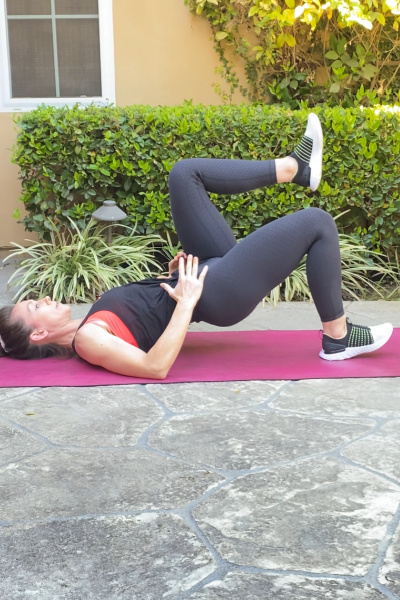10 Symphysis Pubis Dysfunction Exercises to Relieve Pregnancy Pelvic Pain
(This post probably contains affiliate links. I receive a small commission at no cost to you through links shared on this website to help keep the information I provide free to you)
If you have extreme pain in your pelvis or it feels like your pubic bone is going to rip in half during pregnancy, you may have something called “Symphysis Pubic Dysfunction” also referred to as Pelvic Girdle Pain.

Welcome to another post about, “Why didnt anyone tell me about this during pregnancy?”
In today’s post, I discuss something called “Pubic Symphysis Dysfunction” also known as Pelvic Girdle Pain (PGP) which describes the pain you may be feeling in the front center of your pubic bone and the best exercises and tips to manage the pain.
Many moms think they are supposed to just suck up pregnancy aches and pains as part of the process but that couldn’t be further from the truth!
While Pubic Symphysis Dysfunction is extremely common in pregnancy, it can affect each mom differently and there are varying degrees of pain.
I suggest trying different exercises until you find those that work for you and YOUR body.
And as always, I am not a health care provider. Please make sure you are keeping your healthcare provider informed of any aches and pains during pregnancy.
Disclosure: Although I am a certified prenatal/postnatal exercise specialist and personal trainer, I am not YOUR trainer. The content on this blog is for informational purposes only and should not be a substitute of the information and advice you receive from a healthcare professional. This website does not replace the medical advice you receive from your provider.
What is Symphysis Pubis Dysfunction?
Symphysis Pubis Dysfunction (SPD), also referred to as Pelvic Girdle Pain (PGP) is a condition during pregnancy in which there becomes excessive movement and instability of the pubic bone, specifically in the joint that connects the two pubic bones at the front of the pelvis called the “pubic symphysis”.
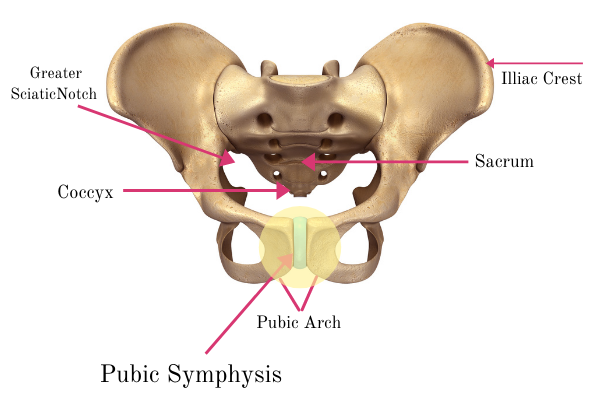
Normally, the pubic symphysis joint is very stable.
However, it quickly becomes dysfunctional if it moves more or less than 2mm.
The good news is that this condition is not harmful to your baby however it could be extremely painful and uncomfortable for you.
What Causes Symphysis Pubis Dysfunction During Pregnancy?
There are FOUR main reasons you may develop SPD during pregnancy.
1. Hormones
During pregnancy, hormonal changes cause ligaments to become more relaxed and stretchy resulting in painful instability of the joint.
As levels of the joint softening hormones relaxin and progesterone begin to rise, the tendons and ligaments of the pelvis become loosened and begin to stretch.
This is a good thing because during childbirth, you need your pelvis to open.
However, problems can arise when these hormones cause an excess laxity of the joints, specifically the pubic symphysis which can result in a lot of pain.
2. Extra Weight Of the Baby
The added weight of your growing baby to an already slightly less stable pelvis can significantly increase pressure on the pubic symphysis.
Remember, the pubic symphysis is a joint and hormones during pregnancy work to soften these joints making them more vulnerable to instabilities and less resistant to added pressure and weight.
3. Extra Pregnancy Weight Gain
Managing weight gain during pregnancy can be challenging.
However, along with potentially unhealthy consequences to both you and your baby, excess weight gain during pregnancy can also place a lot of extra pressure on loosened joints.
This can cause a lot of pain and discomfort
Related: How to Ensure You Gain The Right Amount Of Weight During Pregnancy
4. Muscle Weakness
Painful instabilities in joints most often occur when muscles are weak.
Weak glute, core and back muscles have a harder time providing support and stability to the pelvic floor.
5. Postural Changes During Pregnancy
Posture changes during pregnancy cause lead to more instability in the pelvis and muscle weakness.
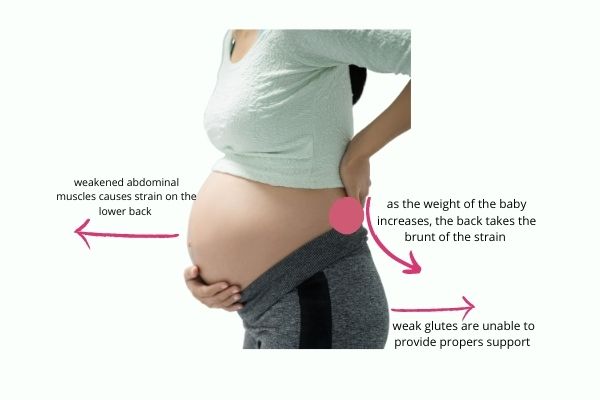
Related: 15 Prenatal Exercises For Instant Back Pain Relief
What Does SPD Feel Like?
The symptoms can range from mild and annoying pain to severe and debilitating pain.
Personally, it has felt as if my pelvis was going to literally rip in half and a sharp/shooting pain in the front of my pelvic bone!
However, the most common symptom of SPD are:
- Pain in the front center of your pubic bone
- Pain in the perineum
- Some people feel pain in their lower back or groin area
The pain is most commonly felt with activities such as:
- Single leg activities which cause your legs to separate such as lunges, stair stepping, certain yoga poses or even walking
- Rolling over in bed or getting out of bed
- Getting in and out of a car
- Anything that causes your legs to widen.
What are the Risk Factors of SPD?
You are more at risk for experiencing SPD if:
- Have a history of Diastasis Recti or have a weak core
- Have weak glute muscles
- Weak pelvic floor muscles
- You have had multiple pregnancies
- Have given birth to a large baby (I believe this is what caused my SPD. My second baby was almost 9 pounds which was huge compared to my first who weighed 6.8 pounds!)
- Prior injury to your pelvis
- If you are overweight or excess weight gain during pregnancy
- This is because the excess downward pressure and weight to the pelvic floor
- Poor posture
- Have a physically demanding job
- Are very athletic/active during pregnancy
Can you Exercise During Pregnancy With SPD
Yes!
And you should because prenatal exercise has numerous benefits for both you and your baby.
However, exercising with SPD can feel very restrictive but it doesn’t have to prevent you from exercising all together.
You can modify almost every single exercise.
I suggest taking note of movements that worsen the SPD pain and avoid or modify those movements.
For example, if regular squats cause pain, try a close stance and use a chair as a guide.
You can also try kneeling squats which should take much of the load off your pelvic floor entirely.
You will benefit most from regularly doing exercises such as the ones I share in this post that focus on strengthening the muscles that support the pelvis.
This includes strengthening the transverse abdominis muscles, obliques, glutes, and adductors (inner thigh)
Will SPD Make Labor More Painful?
For most women, SPD should not affect your labor.
However, if your SPD pain is so severe that you are unable to open your legs during delivery, you may want to discuss options with your health care provider.
Personally, the pain of my contractions made my SPD pain irrelevant!
These labor and delivery courses can help you mentally prepare for the pain you will experience during labor and delivery and help you decide if your SPD pain is sever enough to try a natural birth or get an epidural.
Will SPD Go Away After Pregnancy?
In most cases, SPD should go away with rest and as your hormones return to their pre pregnancy levels.
However, if you are breastfeeding, this can take a little while longer because your body will continue to produce relaxin until you have stopped. (7)
If you still have pain after pregnancy, you can continue doing these strengthening exercises or see a pelvic floor physical therapist who can see you one on one for a more detailed assessment.
Tips to Relieve SPD Pain in Pregnancy
One of the best ways to lessen your chances of developing pregnancy related symphysis pubis dysfunction is to strength train and stay fit PRIOR to pregnancy and during pregnancy.
Keep in mind that pregnancy is very physically demanding on the body and keeping your muscles strong will help counter all the aches and pains that come as your baby grows and your body changes.
Focusing on strengthening the muscles that support the pelvis and weight of the baby will give you the best chance and pain relief.
Here are other ways you can relieve SPD:
- Use a pregnancy support band to help take some of the pressure off the pelvic floor.
- Avoid exercises that you know make it worse.
- For example, if separating your legs is uncomfortable, avoid exercises like lunges, or the stair climber. You may even want to be careful how you roll out of bed or get out of a car. Just be mindful of movements that cause pain and modify or avoid them all together if possible.
- If you have severe SPD, you may need to get help taking care of other children if possible.
- Use cold application to reduce the inflammation and pain. These perineal ice pads are genius!
Summary of managing SPD pain
Do’s
- Wear a support belt to relieve the pressure on your pelvic floor
- Listen to your body and stay as active as possible within your own comfort levels
- Ask for help, especially with heavy lifting
- Sleep with a pillow between your knees and if you need to turn over, keep your knees together
- Sit down to get dressed or undressed if needed
- Take the stairs one at a time
- Wear flat, supportive shoes
- If you sit at a desk, place a foot rest under your feet to take some pressure off your pelvis.
- Sit and stand with correct posture
Don’ts
- Participating in activities or exercises that trigger the pain
- Standing on one leg to get dressed
- Movements that cause your legs to open such as getting out of bed
- Sitting-cross legged
- Opening your legs too wide to get in and out of a car
- Sitting on the floor or low chairs
Exercises for Symphysis Pubis Dysfunction During Pregnancy.
Many moms see tremendous improvement from strengthening their core, glutes, and low back. This will help to stabilize the pelvis and support the weight of your pregnancy.
Some of these exercises on done on your back.
Current research shows that it is safe to perform exercises on your back for short periods of time as long as you do not feel light headed or experience any pain. Roll onto your side in between sets and also to get up and down.
You can also prop yourself up with pillows or blankets if that feels more comfortable at your stage of pregnancy.
1. Diaphragmatic Breathing

Think of diaphragmatic breathing as re-pattering your breathing patterns.
Due to lack of space in your belly during pregnancy, your breathing patterns can become compromised without you even realizing it.
Breathing correctly actually helps your body carry the demand of extra weight better, helping to prevent aches and pains.
It is also a great exercise to help you release stress and tension in your body than can contribute to pain.
- Begin by either sitting comfortably on the floor, yoga ball. After pregnancy, you should practice lying on your back.
- Place your hands on the sides of your rib cage for the mind muscle connection.
- Inhale and while inhaling, imagine your are expanding your ribcage and diaphragm with your breath. During this inhalation, focus on relaxing your pelvic floor.
- Now, as you exhale, make an “sssssss” with your lips and allow your belly to fall back toward the spine as you lift your pelvic floor. Also engage your lower abdominal muscles by imagining you are pulling your two pubic bones together.
- To lift your pelvic floor, imagine lifting a marble with your rectum, a blueberry with your vagina or stopping your urine with your urethra.
- Relax and continue this for 10-15 breaths, several times throughout the day or before any exercise.
2. Pelvic Tilt (standing or lying down)
This simple yet very effective exercise should be done throughout your entire pregnancy to prevent back pain and SPD pain.
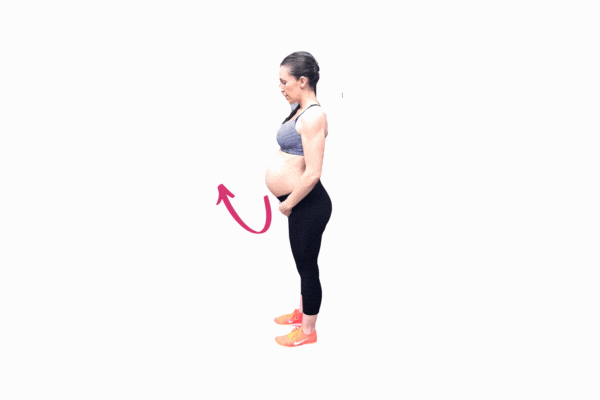
- Start with your back against a wall with your head, upper back and glutes touching the wall. Place your feet slightly out in front of you.
- You will notice a natural curve in your lower back. Your goal is to use your abs to flatten your back against the wall.
- Inhale and on your exhale, engage your core by imagining you are literally hugging your baby with your abs and bringing your belly button toward the wall. This is NOT sucking in!
- This should lift your pelvis and flatten your back against the wall. Make sure to keep your shoulders relaxed.
- Hold for about 3-5 seconds, then release.
- Repeat 8-10 repetitions for 1-3 sets.
3. Bridges With Yoga Ball
This exercise will help strengthen your glutes, inner thigh muscles, pelvic floor and core.
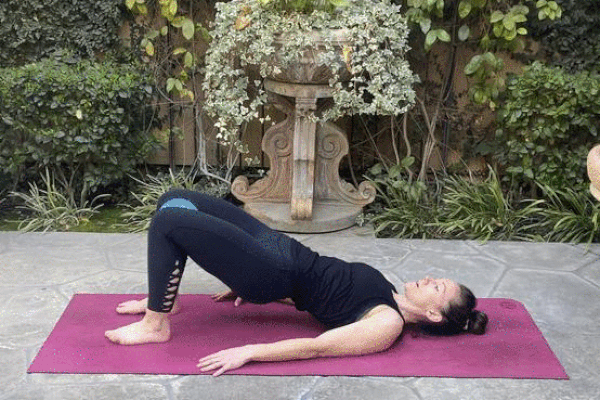
- Gently roll onto your back and place a small yoga ball between your knees.
- Inhale on on your exhale, engage your lower abdominal muscles by doing a small pelvic tilt.
- Press through your feet, squeeze your glues and gently squeeze the ball as you lift your hips up off the ground.
- Make sure your keep your ribs from flaring (keep them down) and your shoulders relaxed.
- Hold at the top, continuing to squeeze the ball and your glutes for 5-8 seconds, then slowly lower
- Repeat 8-10 repetitions for 1-3 sets
- If lying down feels too challenging for you, you can modify this exercise by sitting in a chair with the ball between your knees. You will continue to engage your core and squeeze the ball just as you would in the bridge position however you will not be working your glutes.
4. Kneeling Squats (with ball)
I love the kneeling squat because it really isolates the glutes while taking the pressure off your pelvis.

- Begin kneeling on a soft cushion or blanket under your knees with your knees about shoulder width apart.
- Optional-hold a small ball or yoga block out in front of your. This will help you further engage your deep core muscles.
- Sit back onto your heels and from here, inhale and on the exhale, engage your core and squeeze your glutes to rise up. At the same time, gently squeeze the ball as you continue to imagine lifting your pelvic floor with a kegel.
- Continue squeezing the glutes for about 3 seconds then slowly and in a controlled manner, lower your glutes back down toward your heels.
- Repeat for 10 reps, then rest and repeat 1-3 sets.
- It’s very important to really squeeze your glutes while lifting and engaging your core to get the most out of this exercise.
5. Bird Dogs
This exercise may look simple but when done correctly, it is extremely effective in teaching you to engage your core correctly, activate your glutes in order to stay balanced.

- It is important to focus on keeping your back straight during the entire exercise. You want to keep your pelvis parallel to the ground and use your core to prevent your back from arching or rounding.
- Begin on your hands and knees with your wrists directly under your shoulders and knees under your hips.
- Engage your right glute to extend your leg behind you while extending the opposite left hand in front of you.
- At the top of the position, take a moment to make sure your abs are engaged (think hugging your baby), your back isn’t swaying down toward the ground, one side of your pelvis isn’t lifting up or sinking down and you are squeezing your glute.
- Hold for 5-7 seconds, the repeat on the opposite side
- Continue alternating between sides for about 10-12 reps. Rest for a few moments and repeat for 1-3 sets.
6. Bent Knee Drop
This is an exercise I learned in pelvic floor physical therapy. It looks deceiving in it’s ability to help with SPD pain, pelvic stability and incontinence.
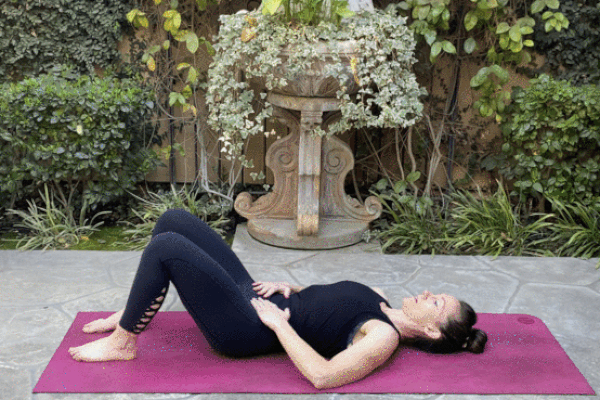
- Begin on your back with your feet flat on the ground. You can prop yourself up on a pillow if that is more comfortable.
- Engage your core by lifting your belly button up an in. (think hug your baby). Also engage your pelvic floor (think Kegel)
- Place your hands on your pelvis to help you feel for movement.
- Your goal is to stabilize the pelvis with your abdominal muscles as you lower your knee.
- Keeping your core engaged, lower one knee down toward the ground WITHOUT allowing movement in your pelvis. You do not need to drop your knee to the ground to benefit from this exercise
- Perform 8-12 reps on one side then switch legs.
7. Clams
This exercise strengthens your glutes and core to help stabilize the pelvis and I see it done incorrectly very often.
The goal of this exercise is to strengthen the glutes and core to stabilize the pelvis.
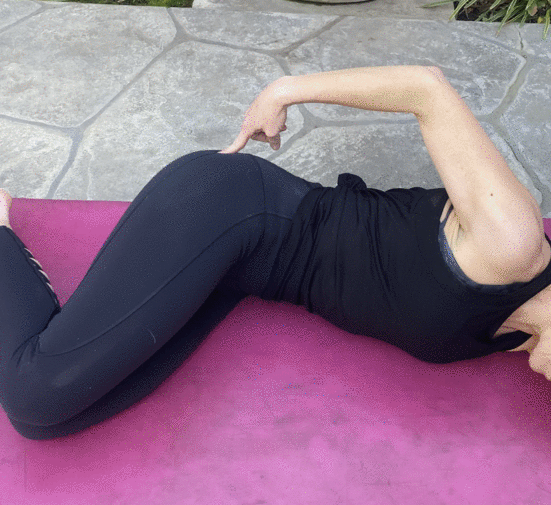
- Begin on your side with your knees bent and head resting on your bottom arm. Make sure to keep your hips stacked to prevent them from sinking forward or falling back.
- Engage your glute (where my finger is pointing) to lift your top leg. Avoid any movement in your pelvis as the leg lifts by firmly engaging your core and glutes.
- Lower and repeat for 10-12 reps before switching sides. Do 1-3 sets on each leg.
- Remember, there should be little to no movement in your pelvis. This will help strengthen your core and glutes for better pelvic stability.
8. Pelvic Drops
This exercise strengthens the muscles located in the side of your hips and buttocks called the “gluteus medius muscles”
These muscles are commonly weak in many women and the are essential for help maintain pelvic stability and normal walking. Keeping these muscles strong will also help with knee and hip pain.
Please hold onto a broomstick or wall for support if needed.
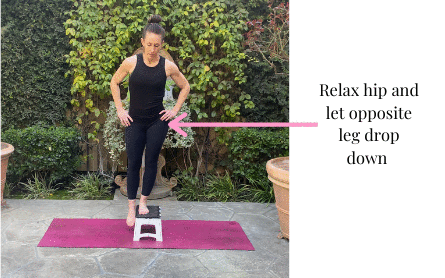
- Start by standing sideways on a step stool or on the bottom step of your stairs with your right foot hanging down toward the ground. Keep your left leg straight during the entire movement. (make sure you hold something for stability if needed).
- Allow your pelvis to drop down toward the right side. Your foot does not need to touch the ground.
- Keeping your abdominals tight, engage your LEFT glute to lift your right leg up so that your pelvis become level. SQUEEZE that left glute very tight.
- You can also try putting your hand on your glute for better mind/muscle connection.
- Repeat 8-10 reps then switch sides. Try 1-3 sets.
Note: this exercise takes some practice and it might not be for everyone! I too REALLY struggled with this but it has made a huge difference in my glute activation and strength.
9. Side Plank or Modified Side Plank
This exercise will help strengthen your oblique muscles and glutes to help with pelvic stability.
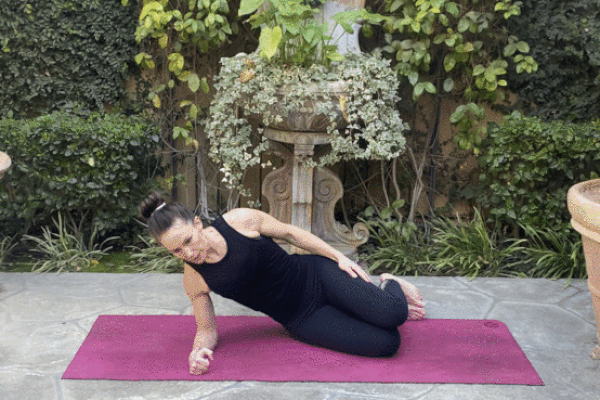
- Begin on your side propped up on your forearm. Your elbow should be directly under your shoulder.
- Engage your glutes and your core to left your hips up off the floor.
- Hold this positing for 15-20 seconds then lower.
- At the top of the position, make sure your glutes are engaged and they are slightly pushing your pelvis forward. Make sure the top of your pelvis is not leaning back or forward and your core is lifted and engaged.
- Perform 8-10 reps then switch sides. Complete 1-3 sets.
10. Donkey Kicks
This is a great exercise for strengthening the glutes and core.
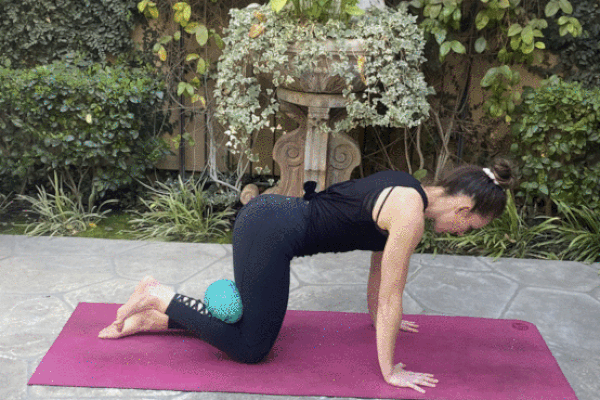
- Begin on your hands and knees with your wrists directly under your shoulders and knees under your hips. You can place a small ball in your knee like I have but it is not necessary.
- Before lifting your leg, squeeze your glute and engage your core. Keep your core firmly engaged to prevent any movement in your pelvis as you lift your leg.
- Keeping your foot flexed, engage your glutes to press your foot up toward the ceiling. Keep squeezing your glute at the top of the exercise. Make sure your back isn’t arching and core is engaged to keep it flat.
- Slowly lower back down and repeat for 10-15 reps each side. Complete 1-3 sets.
Final Thoughts On Managing SPD Pain During Pregnancy
Symphysis Pubic Dysfunction can feel very debilitating and restrictive during pregnancy.
However, taking action as soon as possible is the best way to prevent the pain from getting worse.
If the pain becomes debilitating, please do not hesitate to talk to your healthcare provider about seeing a pelvic floor physical therapist who can do a more hands on assessment.
If you have more questions about SPD, prenatal exercise or just need an online friend to help you through these stages of motherhood, I am only one email away!
FACT CHECK
Struggles of a Fit Mom uses only high-quality sources, including peer-reviewed studies, to support the facts within it’s articles. Read my editorial process to learn more about how I fact-check and keep my content accurate, reliable, and trustworthy.
Sources
1. Aldabe, Daniela & Ribeiro, Daniel Cury & Milosavljevic, Stephan & Bussey, Melanie. (2012). Pregnancy-related pelvic girdle pain and its relationship with relaxin levels during pregnancy: A systematic review. European spine journal : official publication of the European Spine Society, the European Spinal Deformity Society, and the European Section of the Cervical Spine Research Society. 21. 1769-76. 10.1007/s00586-012-2162-x.
2. Howell ER. Pregnancy-related symphysis pubis dysfunction management and postpartum rehabilitation: two case reports. J Can Chiropr Assoc. 2012;56(2):102-111.
3. Hormone Health Network.”Relaxin | Hormone Health Network.” Hormone.org, Endocrine Society, 26 February 2021, 4. 4. What is Relaxin. (2018). Hormone Health Network. What is Relaxin. (2018). Hormone Health Network.
4. What is Relaxin. (2018). Hormone Health Network. https://www.hormone.org/your-health-and-hormones/glands-and-hormones-a-to-z/hormones/relaxin
5. Stuge B, Jenssen HK, Grotle M. The Pelvic Girdle Questionnaire: Responsiveness and Minimal Important Change in Women With Pregnancy-Related Pelvic Girdle Pain, Low Back Pain, or Both. Phys Ther. 2017 Nov 1;97(11):1103-1113. doi: 10.1093/ptj/pzx078. PMID: 29077966.
6. Depledge, J., McNair, P. J., Keal-Smith, C., & Williams, M. (2005, December 1). Management of Symphysis Pubis Dysfunction During Pregnancy Using Exercise and Pelvic Support Belts. OUP Academic. https://academic.oup.com/ptj/article/85/12/1290/2805046
7. Meet Our Sponsor: The Fourth Trimester. (2018). Kelly Mom. https://kellymom.com/sponsors/meet-sponsor-fourth-trimester/


Brooke is a certified Prenatal and Postnatal Exercise Specialist with a Bachelors of Science degree in Kinesiology-Exercise Science. She is also a mom of 3 girls with more than 15 years of experience in health and fitness. Brooke’s goal at Struggles of a Fit Mom is to help motivate, educate and inspire other busy mamas who struggle with finding time, energy and motivation to take care of themselves in the chaos of motherhood.


